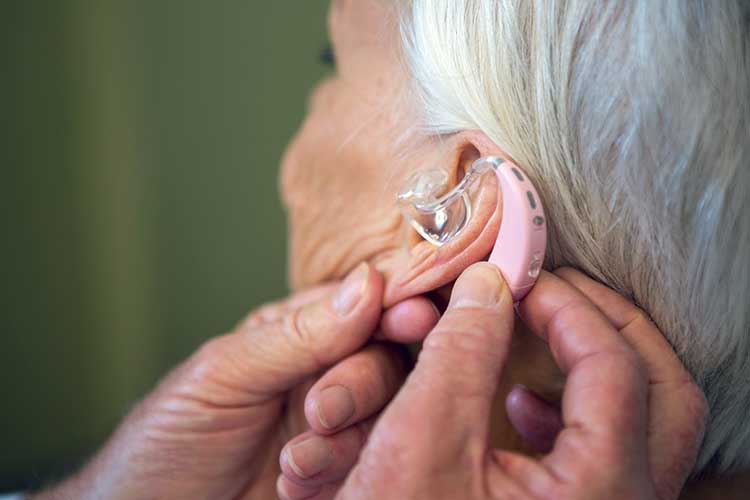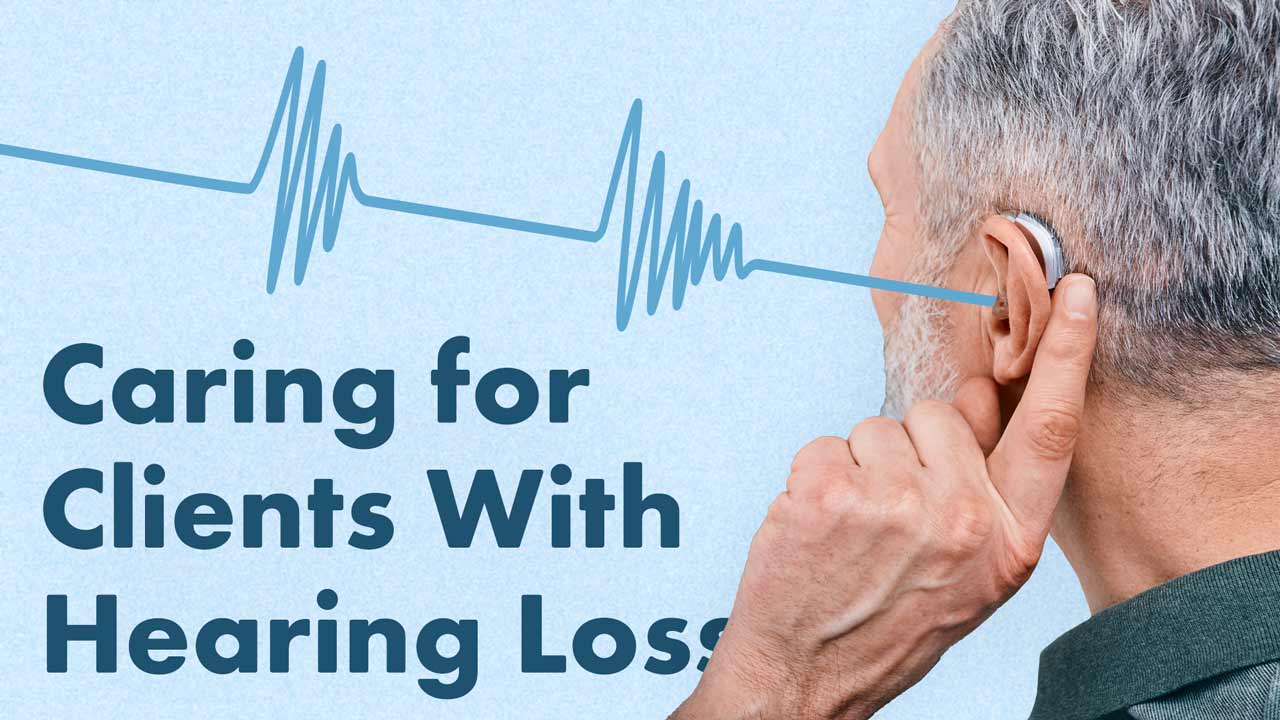Hearing loss is highly prevalent in older adults, especially those who are living in residential aged care (Deafness Forum of Australia 2018).
In Australia, 3.6 million people in total and more than 70% of people over the age of 70 have hearing loss (DoHaAC 2022). Approximately 15% of Australians use hearing aids (AIHW 2016).
Given these statistics, you are likely to encounter clients who have a hearing impairment and use hearing aids, especially when caring for older adults.
It is important to know how to care for these clients and ensure that hearing aids are being used appropriately.
Understanding Hearing Loss
Hearing loss is the reduction of a person’s ability to hear. This is often caused by wear and tear to the hairs or nerve cells in the cochlea over time from ageing and chronic exposure to loud noise, which impairs the electrical signals being transmitted to the brain. Gradual hearing loss caused by age is known as presbycusis (Mayo Clinic 2023).
Other causes of hearing loss include, but are not limited to:
- Congenital causes (can be hereditary or non-hereditary)
- Intrauterine infection (e.g. rubella, cytomegalovirus)
- Birth asphyxia
- Hyperbilirubinaemia
- Low birth weight
- Chronic ear infection
- Infectious diseases (e.g. meningitis)
- Chronic disease
- Smoking
- Impacted ear wax
- Ear or head trauma
- Exosure to loud noises
- Poor nutrition.
(WHO 2023)
Presbycusis is a type of sensorineural hearing loss, meaning it’s caused by damage to the cochlea or auditory nerve. This type of hearing loss is generally irreversible (Healthdirect 2022).
Other types of hearing loss include:
- Auditory processing disorders, which are caused by the inability of the brain to process sound normally.
- Conductive hearing loss, where problems in the outer or middle ear (e.g. earwax build-up, infection, fluid) prevent sound from reaching the inner ear. This type of hearing loss can generally be resolved.
- Mixed hearing loss, which is a nomination of sensorineural hearing loss and conductive hearing loss.
(Healthdirect 2022)
People who have mild to severe hearing loss are considered to be ‘hard of hearing’. People who are Deaf usually have profound hearing loss (very little or no hearing) (WHO 2023).

Barriers to Addressing Hearing Loss
On average, people who use hearing aids have taken 10 years to seek help for their hearing loss (Johns Hopkins Medicine 2022). Furthermore, it’s estimated that only 17% of people who could benefit from a hearing aid are actually using one (Deafness Forum of Australia 2023).
Barriers that may prevent people from addressing hearing loss include cost, perceived difficulty of using hearing aids and unwillingness to accept ageing (Johns Hopkins Medicine 2022).
Some people may have difficulty noticing their hearing loss in the first place because it tends to occur gradually (Hearing Australia 2019a).
Even if healthcare staff recognise the signs of hearing loss, they may misdiagnose it as dementia or a mental health condition due to the ambiguity of certain symptoms (e.g. unresponsiveness and confusion) (Action on Hearing Loss 2020).
Being able to correctly identify the signs of hearing loss is essential, as early detection is crucial for better client outcomes and the fitting of hearing aids (Action on Hearing Loss 2020).
Recognising Hearing Loss in Clients
The following signs might indicate that a client is experiencing hearing loss:
- Often asking people to repeat themselves
- Watching television at a loud volume
- Ringing or buzzing in their ears (tinnitus)
- Straining to hear
- Not hearing everyday sounds (e.g. doorbells and phones)
- Difficulty hearing in noisy environments
- Difficulty hearing and understanding conversations
- Speaking either very softly or very loudly
- Withdrawing from social interactions.
(Hearing Australia 2019a; Healthdirect 2022; Davies 2019)
It’s important to note that high-frequency sounds are generally the first to be affected by hearing loss (Hearing Australia 2019b).
Older adults should undergo a hearing test every 12 months and be referred to a specialist immediately if hearing loss is identified (Hearing Australia 2019b).
The Impacts of Hearing Loss

Hearing loss has been associated with:
- Impaired ability to communicate with others
- Loneliness
- Isolation
- Frustration
- Depression
- Anxiety
- Cardiovascular disease, stroke and obesity
- Cognitive impairment and decline
- An overall decrease in quality of life.
(WHO 2023; Mayo Clinic 2023; Action on Hearing Loss 2020)
What are Hearing Aids?
Hearing aids are electronic devices that increase the volume of sounds, allowing people with hearing loss to hear more easily. They work by receiving sound waves through a microphone and converting them into electrical signals. These signals are then amplified in power and transmitted to the ear using a speaker (NIDCD 2022).
Hearing aids come in a variety of styles:
- Behind-the-ear (BTE) hearing aids consist of a case that fits behind the ear (containing all the electronic components) and an ear mould that connects to the case via a tube.
- Receiver-in-canal (RIC) hearing aids consist of a sound processor behind the ear, connected to a receiver that sits inside the ear canal.
- In-the-ear hearing aids are custom-made to fit the client’s ear. They include:
- In-the-ear (ITE) hearing aids, which fit in the outer ear.
- In-the-canal (ITC) hearing aids, which fit partially inside the ear canal.
- Completely-in-canal (CIC) hearing aids, which fit entirely inside the ear canal.
(NIDCD 2022; Hearing Australia n.d.a, b; Mayo Clinic 2022)
Working with Hearing Aids
Some clients may need assistance with inserting, removing, cleaning and troubleshooting their hearing aids. It is important that you know how to perform these tasks so that you are able to help them if required (Deafness Forum of Australia 2019).
Inserting a Hearing Aid
- Perform hand hygiene.
- Wipe the aid with a tissue, brushing away any earwax. You may need to use the client’s wax cleaning tool to pick wax out of the ear mould.
- Close the battery casing and ensure the aid whistles when you cup your hand around it.
- Carefully insert the hearing aid into the correct ear (the left aid should have a blue dot and the right aid should have a red dot). It should fit inside snugly.
- If the client is using a BTE hearing aid, ensure the tubing is not pinched or twisted.
- Using your normal voice, ask the client two straightforward questions to assess whether the volume is set to an appropriate level.
(Deafness Forum of Australia 2019)

Removing a Hearing Aid
- Use your thumbnail to open the battery casing.
- Gently remove the hearing aid and store it appropriately.
- The hearing aid should be stored with the battery door partially open and battery inside the casing.
(Deafness Forum of Australia 2019)
Changing a Hearing Aid Battery
- Use your thumbnail to open the battery casing.
- Use the magnetic tip of the client’s wax brush to lift the battery out.
- Discard the battery.
- Check the size and expiry date of the new battery.
- Insert the new battery into the casing with the flat side facing upwards.
- Close the battery casing and ensure the aid whistles when you cup your hand around it.
(Deafness Forum of Australia 2019)
Potential Issues With Hearing Aids
When inserting, removing or cleaning a hearing aid, you may experience issues such as:
- The client not hearing any sound
- The client hearing whistling
- Weak sound
- Wax build-up
- Lost or failed batteries.
(Deafness Forum of Australia 2019)
Refer to the Deafness Forum of Australia’s Good Practice Guide for specific troubleshooting tips.
Practical Tips for Caring for Clients With Hearing Loss
- Encourage clients to wear their prescribed hearing aids.
- Ensure clients’ hearing aids are switched on, properly inserted and have working batteries.
- Hearing aids should be cleaned daily.
- Hearing aid batteries should be changed weekly.
- Ensure clients’ hearing aids are kept in a familiar and easily accessible place.
- Ensure hearing aids are kept away from heat and moisture.
- Hearing aids should always be removed before the client showers or uses an electric razor to shave their face.
- Do not use hair dryers or hairsprays near a hearing aid.
- Try to minimise background noise in communal areas, and ensure there are quiet areas without televisions etc. where clients can have conversations.
- When a client first begins to use a hearing aid, the volume should initially be set low and gradually increased to a comfortable level.
- Refer clients to a specialist if you suspect earwax build-up.
- If you suspect an issue with a client’s hearing aid, contact their audiology specialist.
- Take note if a client is frequently adjusting their hearing aid, as this may indicate an issue.
(Health.vic 2015; NIDCD 2022; Action on Hearing Loss 2020; Deafness Forum of Australia 2019)
Communicating with Clients who have Hearing Loss
Read: Sensory Loss in Older Adults
Conclusion
Knowing how to care for and communicate with clients who have hearing loss is essential for their safety, ability to participate in daily and social activities and overall quality of life. This may include assisting with the insertion, removal, cleaning and troubleshooting of hearing aids.
It is also crucial that you can correctly identify the signs of hearing loss and refer clients as soon as possible so that any issues are addressed early.
Test Your Knowledge
Question 1 of 3
How often should hearing aid batteries be changed?
Topics
References
- Action on Hearing Loss 2020, Supporting Older People With Hearing Loss in Care Settings, Action on Hearing Loss, viewed 18 September 2023, https://actiononhearingloss.org.uk/wp-content/uploads/2020/05/A1422_Hear_to_Care_Guide_A4.pdf
- Australian Institute of Health and Welfare 2016, Australia’s Health 2016: Vision and Hearing Disorders, Australian Government, viewed 18 September 2023, https://www.aihw.gov.au/getmedia/48ee92a8-d373-4354-8df2-d664a974034f/ah16-3-15-vision-hearing-disorders.pdf.aspx
- Davies, A 2019, ‘Hearing Loss: Essential Knowledge and Tips for Nursing Practice’, Nursing Times, vol. 115 no. 11, viewed 18 September 2023, https://www.nursingtimes.net/clinical-archive/assessment-skills/hearing-loss-essential-knowledge-and-tips-for-nursing-practice-21-10-2019/
- Deafness Forum of Australia 2023, Causes, Impacts, Prevention, Identification, Management, Deafness Forum of Australia, viewed 18 September 2023, https://www.deafnessforum.org.au/deafness-and-hearing-loss-causes-impacts-prevention-identification-and-management-global-strategy/
- Deafness Forum of Australia 2018, Good News at Last About Hearing Assistance in Aged Care, Deafness Forum of Australia, viewed 18 September 2023, https://www.deafnessforum.org.au/good-news-at-last-about-hearing-assistance-in-aged-care/
- Deafness Forum of Australia 2019, Good Practice Guide: Reference Resources for Aged Care Hearing Assistance Programs, Deafness Forum of Australia, viewed 18 September 2023, https://www.deafnessforum.org.au/wp-content/uploads/2019/09/GPG-23rd-Sept-2019.pdf
- Department of Health and Aged Care 2022, About Ear Health, Australian Government, viewed 18 September 2023, https://www.health.gov.au/topics/ear-health/about
- Healthdirect 2020, Hearing Loss, Healthdirect, viewed 18 September 2023, https://www.healthdirect.gov.au/hearing-loss
- Health.vic 2015, Communicating with Older People who Have Diverse Needs, Victoria State Government, viewed 18 September 2023, https://www2.health.vic.gov.au/hospitals-and-health-services/patient-care/older-people/comm-topics/communication/communication-needs
- Hearing Australia 2019a, Everything you Need to Know About Hearing, Hearing Australia, viewed 18 September 2023, https://www.hearing.com.au/Hearing-loss
- Hearing Australia 2019b, Hearing Australia and Aged Care Services, Hearing Australia, viewed 18 September 2023, https://www.hearing.com.au/Resources-for-health-professionals/Aged-Care-Providers
- Johns Hopkins Medicine 2022, The Hidden Risks of Hearing Loss, The Johns Hopkins University, viewed 18 September 2023, https://www.hopkinsmedicine.org/health/wellness-and-prevention/the-hidden-risks-of-hearing-loss
- Mayo Clinic 2022, Hearing Aids: How to Choose the Right One, Mayo Clinic, viewed 18 September 2023, https://www.mayoclinic.org/diseases-conditions/hearing-loss/in-depth/hearing-aids/art-20044116
- Mayo Clinic 2023, Hearing Loss, Mayo Clinic, viewed 18 September 2023, https://www.mayoclinic.org/diseases-conditions/hearing-loss/symptoms-causes/syc-20373072
- National Institute on Deafness and Other Communication Disorders 2022, Hearing Aids, National Institutes of Health, viewed 18 September 2023, https://www.nidcd.nih.gov/health/hearing-aids
- Victoria Department of Health 2012, Best Care for Older People Everywhere, VIC DoH, viewed 17 September 2020, https://www2.health.vic.gov.au/Api/downloadmedia/%7BD6C6410F-05BA-4962-85F0-8C0DBD86B625%7D
- World Health Organisation 2023, Deafness and Hearing Loss, WHO, viewed 18 September 2023, https://www.who.int/news-room/fact-sheets/detail/deafness-and-hearing-loss
Additional Resources
- Supporting Older People With Hearing Loss in Care Settings | Action on Hearing Loss
- Good Practice Guide: Reference Resources for Aged Care Hearing Assistance Programs | Deafness Forum of Australia
- Hearing Australia
- Caring for Clients with Corrective Lenses (Glasses and Contacts) | Ausmed Article
- Sensory Loss in Older Adults | Ausmed Article
 New
New 
